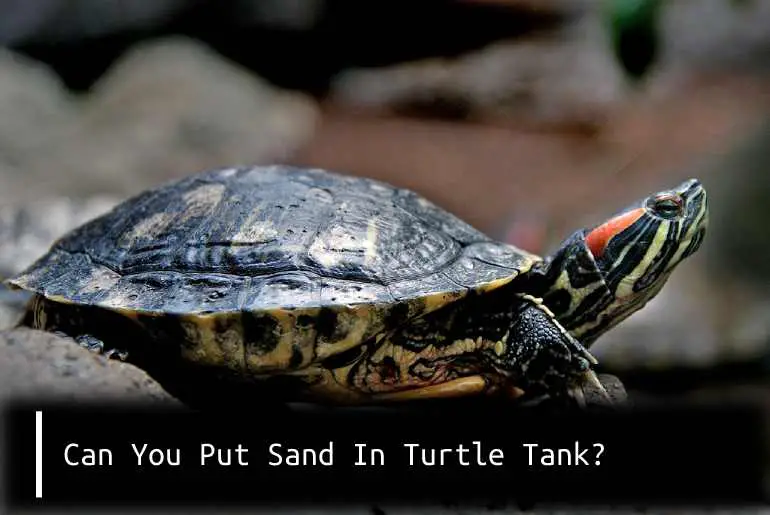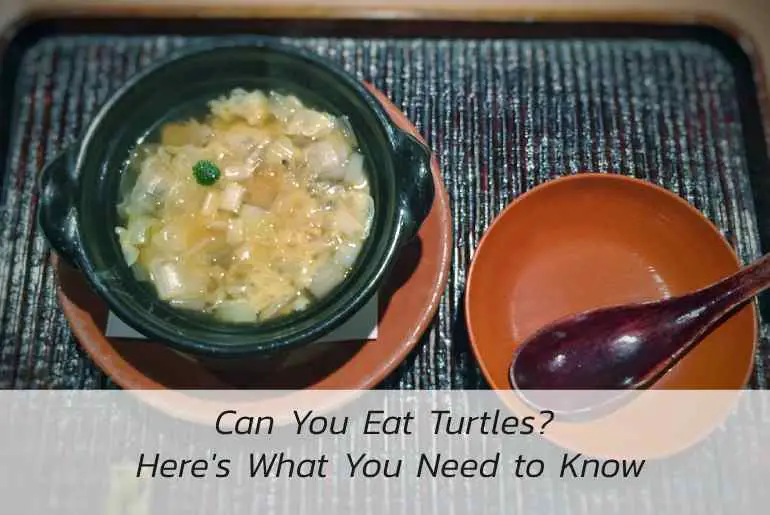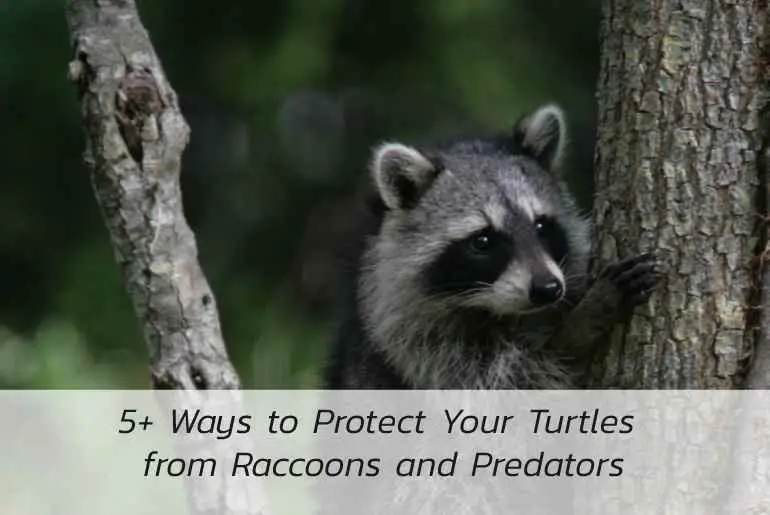Every tank needs substrate in it. The tank without substrate does not look that well. Thus, turtles also enjoy some substrate, right? But what should you put in your turtle tank? Is sand better or gravel or a bare bottom? Let us find out!
Turtles like both sand and gravel. But what is best for your turtle depends on the type of turtle you are keeping in your aquarium and your personal preferences too!
Can You Put Sand In the Turtle Tank?
Sand in the turtle tank seems to be a good idea. So, yes, you can put sand in your turtle tank. Turtles are soft-shelled and have a soft bodies too! Thus, having a substrate that is soft will be a good choice for their body.
On the other hand, it is generally not recommended to use sand as a substrate in a turtle tank. Turtles can accidentally ingest sand while feeding, which can lead to digestive problems. In addition, sand can be difficult to clean and can harbor harmful bacteria.
Instead, it is better to use a substrate that is safe for turtles, such as smooth river rocks, small pebbles, or a commercial reptile carpet. These substrates are easier to clean and safer for your turtle.
Yes, it is possible to put sand in a turtle tank. However, it is important to make sure that the sand is appropriate for use in a turtle habitat and that it is properly cleaned and prepared before adding it to the tank. Sand can provide a natural substrate for a turtle to dig and burrow in, and it can also help to create a more naturalistic appearance in the tank.
However, sand can also harbor bacteria and parasites if it is not properly cleaned, so it is important to ensure that it is safe for your turtle before adding it to the tank. Additionally, some turtle species, such as box turtles, may have difficulty digesting sand if they accidentally ingest it while feeding, so it is important to monitor your turtle’s behavior and health closely when using sand in the tank.
Why Should You Use Sand As Substrate For Turtles?
Sand is also a good option for the substrate in your turtle tank. Why? Because it is easy to keep, warm and safe. It is also easy to find! Let’s see other plus points of using a substrate for the turtles.
There are several reasons why sand may be a good choice as a substrate for a turtle tank:
Naturalistic Appearance
Sand can help to create a more naturalistic environment for your turtle, as many species of turtles are found in habitats with sandy substrates in the wild.
Digging and Burrowing
Some turtles, such as box turtles, enjoy digging and burrowing in their substrate. Sand can provide a suitable substrate for these behaviors.
Overall, sand can be a good choice as a substrate for a turtle tank, as it can provide a naturalistic appearance and allow for digging and burrowing behaviors. However, it is important to properly clean and prepare the sand before adding it to the tank and to monitor your turtle’s behavior and health closely when using sand as a substrate.
Easy to Clean
Sand can be easy to clean, as it can be removed and replaced on a regular basis. This is especially true if you use fine-grained sand that does not compact easily.
Sand can make it easier to spot and remove turtle poop from the tank. The bright color of baby sand can make it easier to see any waste or debris in the tank, which can help to keep the tank clean and hygienic.
It is also true that sand does not have the same crevices and gaps as gravel, which can make it easier to scoop out waste and debris. However, it is important to keep in mind that fine waste, such as urine, can be more difficult to clean from a sandy substrate, as it can be more easily absorbed into the sand. It is, therefore, important to change the water in the tank regularly to prevent the buildup of toxic substances.
Aesthetic Appeal
Sand can also add an aesthetic appeal to your turtle tank, as it can create a visually pleasing and attractive environment for your turtle.
Sand Is Warmer
It is true that sand can hold heat better than other substrate materials, such as gravel or rocks. This can be beneficial for turtles, as they are ectothermic animals that rely on external sources of heat to regulate their body temperature. A warmer substrate can help to keep your turtle warm, especially if it is kept in a cooler room or area of the house.
However, it is important to note that sand should not be the only source of heat for your turtle. Turtles also need a heat source, such as a basking light or heat lamp, to provide them with the heat they need to stay healthy. The temperature of the substrate should also be monitored carefully to ensure that it is not too hot for your turtle, as excessive heat can be harmful.
Turtles Do Not Choke On Sand
It is generally not common for turtles to choke on the sand. However, it is important to monitor your turtle’s behavior and health closely when using sand as a substrate. some turtles may accidentally ingest small amounts of sand while feeding. If a turtle ingests too much sand, it can cause digestive issues and may lead to the formation of intestinal blockages.
To reduce the risk of your turtle ingesting sand, it is important to keep the sand clean and free of any food debris. You should also avoid overfeeding your turtle, as this can increase the risk of it accidentally swallowing sand while searching for food.
It is also a good idea to provide your turtle with a varied diet. It includes a mix of leafy greens, vegetables, and commercial turtle pellets or other protein sources. This can help to ensure that your turtle is getting the nutrients it needs and can help to reduce the risk of it swallowing sand while searching for food.
Overall, it is generally not common for turtles to choke on the sand, but it is important to monitor your turtle’s behavior and health closely when using sand as a substrate and to take steps to reduce the risk of your turtle ingesting sand.
Sand should be used with caution in a turtle tank. Sand can harbor bacteria and parasites if it is not properly cleaned. So it is important to ensure that it is safe for your turtle before adding it to the tank. Additionally, some turtle species, such as box turtles, may have difficulty digesting sand if they accidentally ingest it while feeding, so it is important to monitor your turtle’s behavior and health closely when using sand in the tank.
What Kind Of Sand To Keep In A Turtle Tank?
When choosing sand for a turtle tank, it is important to select a type of sand that is safe for use in a turtle habitat, and that is appropriate for the size and species of your turtle.
Play Sand
One type of sand you can use in turtle tanks as play sand. This fine-grain sand is typically sold in bags at home improvement or hardware stores. It is relatively inexpensive and easy to find, and it can provide a suitable substrate for turtles to dig and burrow in. However, it is important to make sure that the play sand is properly cleaned and rinsed before adding it to the tank to remove any dust or debris.
Reptile Sand
Another option is reptile sand. i for use in reptile habitats. This type of sand is typically finer and more refined than play sand, and it is often available in a variety of colors. Reptile sand is generally safe for use in a turtle tank, but it can be more expensive than play sand.
It is also important to consider the size of the sand grains when choosing sand for your turtle tank. For smaller turtles or turtles with delicate skin, it may be best to use fine-grained sand to reduce the risk of injury or irritation. For larger turtles or turtles with tougher skin, coarser sand may be more suitable.
Overall, it is important to choose a type of sand that is safe and appropriate for your turtle and to properly clean and prepare the sand before adding it to the tank.
You might also be interested in the following topics:
- Can Turtles Eat Spiders? Will Your Turtles Die?
- Do Catfish Eat Turtles? – The Complete Guide
- 5+ Ways to Protect Your Turtles from Raccoons and Predators
- Fun Facts About Turtles: Are Rainbow Turtles Real?
Sand Vs. Gravel: Which One Is Better For Turtle Tank
Both sand and gravel can be suitable substrate options for a turtle tank, and the best choice for your turtle will depend on a number of factors, including the size and species of your turtle, your personal preferences, and the size and layout of your tank.
Sand has several advantages as a substrate for a turtle tank. It can provide a naturalistic appearance and allow for digging and burrowing behaviors, and it can also hold heat better than gravel, which can be beneficial for turtles. Sand is also relatively easy to clean, as it can be removed and replaced on a regular basis.
However, sand can also have some drawbacks. It can be more expensive than gravel, and it can also be more difficult to clean if fine waste, such as urine, is absorbed into the sand. Additionally, some turtle species, such as box turtles, may have difficulty digesting sand if they accidentally ingest it while feeding.
On the other hand, Gravel has some advantages and disadvantages as a substrate for a turtle tank. It is generally less expensive than sand and easier to clean, as waste and debris can be scooped out of the gravel. However, gravel does not provide the same naturalistic appearance as sand and does not allow for digging and burrowing behaviors. Gravel can also be harder on a turtle’s feet and may not hold heat, as well as sand.
Overall, both sand and gravel can be suitable substrate options for a turtle tank, and the best choice for your turtle will depend on your specific needs and preferences. It is important to consider the size and species of your turtle, the size and layout of your tank, and the potential benefits and drawbacks of each substrate material when making your decision.
Cleaning
It is easier to clean the tank when the substrate is softer which is sand. Poop gets trapped in the gravel. Thus, it is harder to clean the gravel.
In sand, the leftovers and molts are hard to pick, but in gravel, it is easier to clean.
Water Filter
Sand is easily to be pulled up by the aquarium filter. In that case, water filters will wear out soon. However, in the gravel, it does not get easily captured by the water filter.
Digestion
Some turtle species may have difficulty digesting sand if they accidentally ingest it while feeding. This can lead to digestive issues and may cause the formation of intestinal blockages.
Gravel is less likely to cause digestive issues in turtles than in sand. This is because gravel is larger and less likely to be ingested accidentally. However, it is still possible for turtles to swallow gravel if they feed on food items mixed in with the gravel or accidentally swallow the gravel while digging or burrowing in the substrate.
To reduce the risk of digestive issues in your turtle, it is important to monitor your turtle’s behavior and health closely and to take steps to prevent it from swallowing sand or gravel.
This can include keeping the substrate clean and free of food debris, and avoiding overfeeding your turtle. You can provide a varied diet that includes a mix of leafy greens, vegetables, and commercial turtle pellets or other protein sources.
Appearance
Sand and gravel can both be used as substrate materials in a turtle tank. The best choice for your turtle will depend on your personal preferences and the size and layout of your tank.
Moreover, sand can provide a more naturalistic appearance in a turtle tank. many species of turtles are found in habitats with sandy substrates in the wild. Sand can also allow for digging and burrowing behaviors, which can be beneficial for some species of turtles.
Gravel, on the other hand, may not provide the same naturalistic appearance as sand, but it can still create a visually pleasing environment for your turtle. Gravel is available in a variety of colors and sizes. And it can be used to create different patterns and designs in the tank. However, gravel does not allow for digging and burrowing behaviors. It may not be as aesthetically pleasing to some people as sand.
Cost
The cost of sand versus gravel for turtles can vary depending on a number of factors. It includes the type of sand or gravel, the size of the turtles, and the size of the enclosure. In general, sand is usually more expensive than gravel because it is finer and requires more processing.
However, there are also some types of sand that are more expensive than others, such as coral sand or aragonite sand. Gravel, on the other hand, is usually less expensive than sand because it is coarser and requires less processing. The size of the turtles can also affect the cost. Larger turtles may require more sand or gravel to adequately cover the bottom of their enclosure.
Finally, the size of the enclosure can also affect the cost. A larger enclosure will require more sand or gravel to adequately cover the bottom.
Ease On Digging
Sand and gravel can both be easy or difficult to dig in, depending on the specific properties of the material and the tools being used. In general, sand is usually easier to dig in than gravel because it is finer and more pliable. This is due to the smaller particle size of sand. It allows it to flow more easily and be scooped or shoveled.
On the other hand, Gravel is usually more difficult to dig in because the larger particles can be more difficult to move and manipulate. Gravel is also more prone to compaction, which can make it harder to dig through.
However, the specific properties of the sand or gravel and the tools being used can also affect the ease of digging. For example, wet sand or gravel may be easier to dig in than dry sand or gravel, and certain tools, such as a digging fork or a spade, may be more effective for digging in certain materials than others.
Better Heat Trapper
Both sand and gravel can be good heat trappers. But they have different properties that may make them more or less effective in different situations. In general, sand is a better heat trapper than gravel because it has a higher specific heat capacity. It can absorb and retain more heat energy per unit of mass than gravel.
This is due to the smaller particle size of sand. It allows it to absorb and retain more heat energy in the form of molecular motion. On the other hand, Gravel has a lower specific heat capacity. The larger particles do not absorb and retain as much heat energy.
However, the ability of sand or gravel to trap heat can also depend on other factors, such as the thickness of the layer and the type of material. For example, a thick layer of sand or gravel may be able to trap more heat than a thin layer, and certain types of sand or gravel may be more effective at trapping heat than others.
Keeping Tank Mates: Sand Vs. Gravel
Both sand and gravel can be suitable substrate options for keeping tank mates in an aquarium or terrarium. But they have different properties that may make them more or less suitable for different types of tank mates. Sand is a good substrate option for keeping tank mates. This is because it is soft and comfortable for them to walk on and easy to clean and maintain.
However, sand can be more difficult to keep clean in tanks with messy or burrowing tank mates. It can easily become clouded or stirred up. Additionally, some tank mates, such as certain types of fish or invertebrates, may be more prone to accidental ingestion of sand, which can cause health problems.
Gravel, on the other hand, is a good substrate option for keeping tank mates. It is easy to clean and maintain, and it is also less prone to being ingested by tank mates.
However, gravel can be more uncomfortable for some tank mates to walk on. It can also be more difficult to create a comfortable and naturalistic habitat in a tank with gravel substrate. Additionally, gravel may not be suitable for certain types of tank mates, such as burrowing animals, because it can be more difficult for them to dig and create burrows.
Final Words On Can You Put Sand In Turtle Tank
Yes, you can put sand in your turtle tank, but it has its own pros and cons. Personally, I will suggest you use sand if you find it hard to clean up poops, but if you want to be at ease with your equipment, you can always go for gravel.
You might also want to read:






